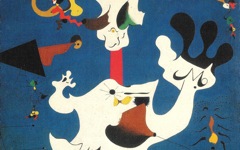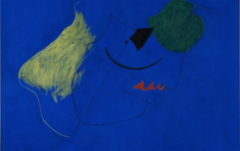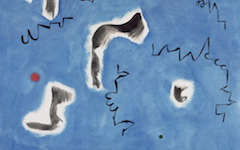Miró‘s The Podiatrist (1901)
Ten years ago EPPH showed how Joan Miró repetitively shaped “abstract” forms into the letters of his name (M, I, R and Ó), a constant method between 1937 when he was 44 until shortly before he died more than four decades later. This 1901 drawing by the eighteen-year old artist now demonstrates that the practice began much earlier. We cannot know what prompted it but, as revealed on this site, Miró could have learnt it from viewing other art.1 The inclusion of their own name or initials in the guise of external objects is extremely common among artists of comparable stature. Some of Picasso’s juvenilia is similarly based on the letters of his name as is much of his later work too.

Joan Miró, The Podiatrist (1901) Graphite pencil, watercolor and ink on paper. Fondació Joan Miró, Barcelona.
Click image to enlarge.
The Podiatrist, unimpressive as art, still prefigures Miró’s turn to abstraction. Not only does the patient dwarf the physician but few objects are recognizable. What, for instance, is that r-shape behind the chair or its j-shaped counterpart near the podiatrist, each echoing the human legs? The blue eye-like circle above the podiatrist’s head is equally indecipherable as is the bulbous outline at the right edge.
Click next thumbnail to continue
However, when viewed in light of how EPPH interpreted his later work, the curiosities still spell J. Miró. On either side of the oval frame there are the j- and r-forms mentioned. The frame itself is the ó with its accent. The chair legs are M-shaped though unevenly separated as is the upper-case M in his signature. And directly behind the podiatrist’s back is the only vertical line of the wall with a curve, a lower-case i.
Click next thumbnail to continue
Scholars already know that up until 1928 the rendering and placement of his signature was very important to Miró.2 No wonder. Yet they are curious as to why after 1929 Miró never signed his works.3 He didn't have to. Miró’s artworks are a “depiction” of his name needing no signature. They are signatures themselves.
More Works by Miró
Discover yet another example of how Miró's composition is based on his own name

Miró‘s Potato (1928)
Notes:
1. See examples under the theme Letters in Art
2. Joan Miró: Painting and Anti-Painting, 1927-1937 (Museum of Modern Art) 2008, p. 54
3. Tomas Llorens, Miró: Earth (Madrid: Museo Thyssen-Bornemisza) 2008, p. 94
Original Publication Date on EPPH: 17 Apr 2021. © Simon Abrahams. Articles on this site are the copyright of Simon Abrahams. To use copyrighted material in print or other media for purposes beyond 'fair use', you must obtain permission from the copyright owner. Websites may link to this page without permission (please do) but may not reproduce the material on their own site without crediting Simon Abrahams and EPPH.



